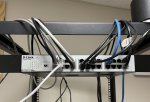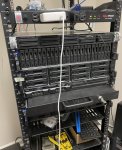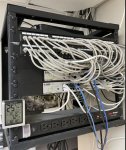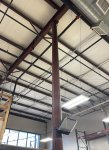Thanks Josh; great info.
Lowest hanging fruit is firewall and wifi. I'd replace the Synology stuff with a business-class wired router/firewall (in the network rack) and controller-based, scalable wifi APs. For router/firewall, you could do something basic like a Unifi USG or EdgeRouter 4, or for something more security-oriented, a pfSense or Untangle appliance, or full-blown corporate firewall like a Fortinet (right size would probably be a FortiGate 40F or 60F). For wifi, could definitely do UniFi; I also like Cisco CBW (controller is embedded in the AP firmware, so one less single point of failure, plus you get multi-master fail-over), or if you have the cash, go Ruckus, for superior interference mitigation. Here's a possible layout of APs:
APs 1 and 2 (office ceiling) and AP5 (mezzanine ceiling) would be lower-power 2x2 (ex: Unifi AC-LITE, Cisco CBW140AC, Ruckus R510); these will service clients in the lower-density areas. APs 3 and 4 would be higher-density, longer ranger models, with 3x3 or 4x4 radios (ex: UAP-HD, CBW240AC, R710), mounted on the ceilings, or lower, on pieces of conduit, say 10 feet down from the ceiling; those two would cover each of the two main warehouse rooms. Roaming between all APs should be fairly seamless, although Apple devices have been known to be notoriously "sticky", at least on older hardware and/or versions of iOS, so that's something to take into account. You'll definitely want a system that allows for max ability to tweak roaming behavior; the enterprise products are tops for that (Aruba, Ruckus, etc.).
One other possibility, which may be overkill for your size warehouse, but I'll mention it nonetheless, would be CBRS (citizen's band radio service) based private-spectrum LTE, (provided your iPads and other warehouse endpoints were equipped with LTE/mobile-broadband). This technology allows for man more endpoint-to-AP connections versus conventional wifi, plus very usable signal at extremely low attenuation (think -120dB), so good performance for when devices are buried in the corner of the warehouse, behind metal shelving, and/or flying around on a forklift at 20 mph. Example hardware would be
Ruckus Q-series APs. Shortly after purchase, you'd have to go through an application process to be licensed a piece of LTE spectrum in your local jurisdiction (that's how powerful it is!). Again, probably overkill for your size warehouse, but that's the way the larger installs are going, so if you ever have any plans to expand, just something to keep in mind.
Also, what is the room with a "?" in it -- a clean room, storage room, or just dead space? Will it need wifi, too? If so, what are the walls made of?
Next level to address, if you have the funds, would be cabling and switching.
Cabling - It appears you have solid-core Cat5e running to the patch panel, plus stranded-core patch cables running directly into the switches. If those stranded cables were used for long in-wall or ceiling runs, I'd replace with more solid-core Cat5e (or Cat6), terminated to keystones in another patch panel (then patched into your switches). Connectivity may not "work" any better if those runs only lead to desktops or non-PoE devices close by, but if distance is longer (100 ft plus)and/or carrying PoE and/or experiencing higher levels of EMI (perhaps from the warehouse floor), then solid-core could make a difference.
Switching - I'd presume D-Link is working well enough, but I wonder if you'd be able to consolidate a few of those lower-density switches into fewer higher-port models, for a more flat LAN with fewer potential bottlenecks. I realize just that alone may not be worth dumping a large sum on all-new switches, but if you were consider it, I'd look at models with 10Gb uplinks. I like Cisco SG or CBS, UniFi switches
only if using their wifi, otherwise refurb enterprise (Catalyst, HPE 2530 and up, Juniper EX, etc.).
So there you go, that's what came off the top of my head. Any questions, feel free.






